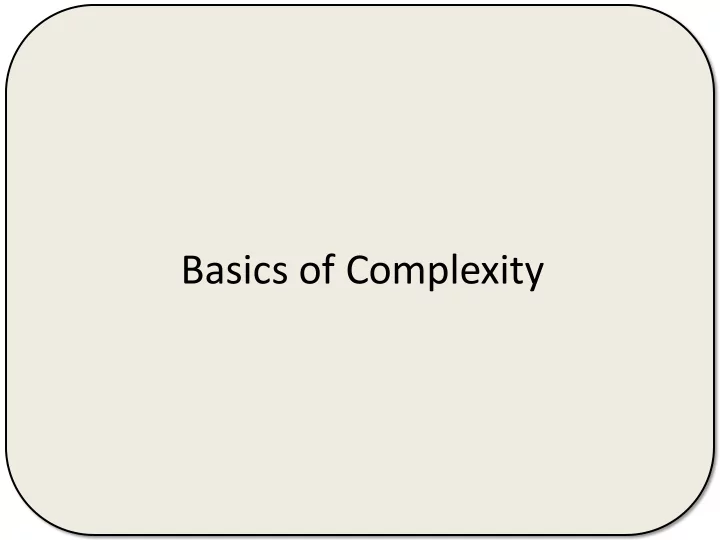

Basics of Complexity
“Complexity” = resources • time • space • ink • gates • energy
Complexity is a function • Complexity = f (input size) • Value depends on: – problem encoding • adj. list vs. adj matrix – model of computation • Cray vs TM ~O(n 3 ) difference
TM time complexity Model: k -tape deterministic TM (for any k ) DEF: M is T(n) time bounded iff for every n , for every input w of size n , M(w) halts within T(n) transitions. – T(n) means max { n +1, T(n) } (so every TM spends at least linear time). – worst case time measure – L recursive à for some function T, L is accepted by a T(n) time bounded TM.
TM space complexity Model: “Offline” k -tape TM. read-only input tape k read/write work tapes initially blank DEF: M is S(n) space bounded iff for every n , for every input w of size n , M(w) halts having scanned at most S(n) work tape cells. – Can use less than linear space – If S(n) ≥ log n then wlog M halts – worst case measure
Complexity Classes Dtime( T(n) ) = { L | exists a deterministic T(n) time-bounded TM accepting L } Dspace( S(n) ) = { L | exists a deterministic S(n) space-bounded TM accepting L } E.g., Dtime( n ), Dtime( n 2 ), Dtime( n 3.7 ), Dtime( 2 n ), Dspace(log n ), Dspace( n ), ...
Linear Speedup Theorems “Why constants don’t matter”: justifies O( ) If T(n) > linear * , then for every constant c > 0, Dtime( T ( n )) = Dtime( cT ( n )) For every constant c > 0, Dspace( S ( n )) = Dspace( cS ( n )) (Proof idea: to compress by factor of 100, use symbols that jam 100 symbols into 1. For time speedup, more complicated.) * T(n)/n à ∞
Tape Reduction If L is accepted by a S(n) space-bdd k -tape TM, • then L is also by a S(n) space-bdd 1-tape TM. Idea: M’ simulates M on 1 tape using k tracks If L is accepted by a T(n) time-bdd k -tape TM, • then L is also accepted by: A ( T(n) ) 2 time-bdd 1-tape TM [proved earlier] – A T(n) log T(n) time-bdd 2-tape TM [very clever] –
Time & Space Hierarchies With more time or space, we can compute more If inf n à ∞ S 1 (n)/S 2 (n) = 0 (e.g., S 1 = o(S 2 )) Then Dspace(S 1 (n)) Dspace(S 2 (n)) If inf n à ∞ T 1 (n) log T 1 (n) / T 2 (n) = 0 Then Dtime(T 1 (n)) Dtime(T 2 (n)) also requires that S 1 , S 2 , and T 2 are “constructible”
Time & Space Hierarchies . . . . . . Dtime(n 3 ) Dspace(n 3 ) Dtime(n 2 ) Dspace(n 2 ) Dtime(n log n) Dspace(n) Dtime(n) Dspace(log n) TIME SPACE
Relationships between Time & Space • Dtime( f ( n )) Dspace( f ( n )) You can only use as much space as you have time Different constant c for each L • Dspace( f ( n )) Dtime( c f ( n ) ) Equivalently, 2 O( f ( n )) [ if f is constructible and f ( n ) ≥ log n ] If you only have f ( n ) space, the number of IDs is bounded by c f (n) before you start looping, so may as well halt. [exercise: what is c ? ]
Goal: define “efficient” computation P = Dtime( n k ) k ≥ 0 “Deterministic Polynomial Time” Union over all polynomials p of Dtime( p ( n )))
Worst-case Advantages • easy to analyze • gives guarantee • don’t have to decide what “typical” inputs are Disadvantages • bizarre inputs created by bored mathematicians proving lower bounds can force algorithms to take longer than any input you’re ever liable to see
Reasons why P is a bad def • Worst case • Asymptotic • Ignores constants: 10 100 n versus 10 -100 2 n
Reasons why P is a good def • Model invariance (RAM, TM, Cray, ...) • Invariant to input encoding • poly(poly(n)) = poly(n), so “efficient” composes • Typical algs found are O( n small-constant ) • Moderate growth rate of polys vs. exps...
Understatement: Exponentials are Big Death of Sun: 5 GigaYears
Understatement: Exponentials are Big Death of Sun: 5 GigaYears
Recommend
More recommend